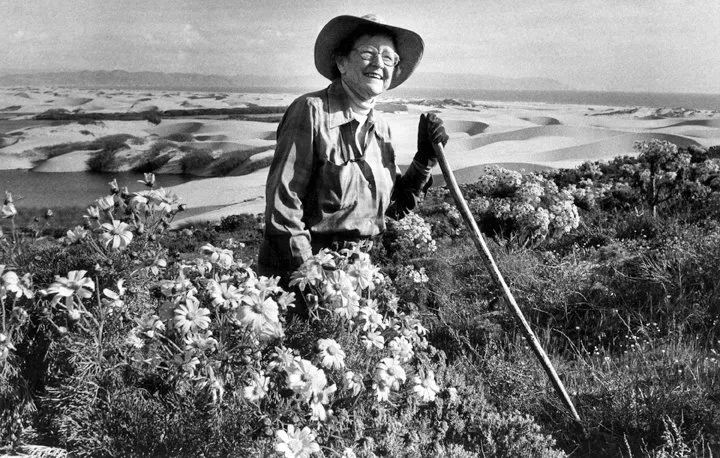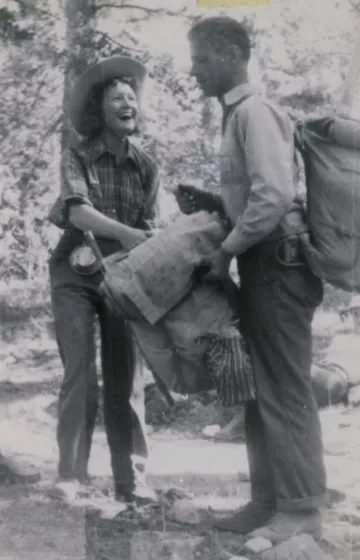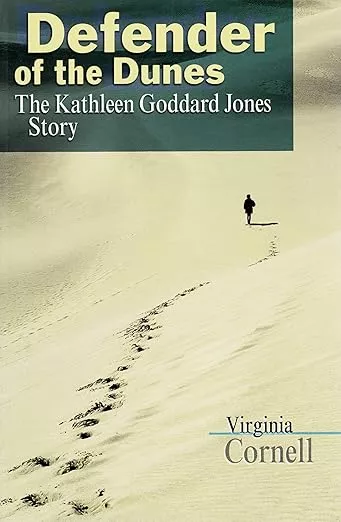This is the first of a two part series on Sierra Club leader Kathleen Goddard Jones written by Santa Barbara-Ventura Chapter Director Jonathan Ullman

After a decade living in India, Burma, Iran, Washington and New York City, Kathleen Goddard was glad to return to her “beloved land,” the central coast of California.
It was a place she knew well from childhood, hiking and camping with her parents and her Santa Barbara church’s “Campfire Girls.”
Years later while studying at Mills College, a shared interest in the outdoors led to a relationship with music professor, violinist and wildlife photographer Cedrick Wright. Wright introduced her to his best friend and mentee, Ansel Adams.
She would later marry Persian and American aviator Ali Shirazi Parvaz and work for NBC Radio until the end of World War II. In 1945, she remarried to Santa Barbaran Duncan Jackson and the couple adopted six children. She made time for walks in nature with other outdoor enthusiasts.
She had also maintained her correspondence with the now married photographer Cedrick Wright.
“Now you can join the Sierra Club,” he had said when she returned to California.
Photographers Wright and Ansel Adams were now part of a who’s who of mid-century outdoor artists and writers, who like John Muir before them, would bring the Sierra Nevadas landscapes to coffee tables in magazine articles and books.
Kathleen wanted to get back to that world and reconnect with her “mentors,” on excursions.
In 1949, Kathleen became a Sierra Club member and joined other Santa Barbara outdoors advocates and enthusiasts like Pearl Chase, at a meeting at the Montecito School for Girls. There they voted to formally petition for a new Santa Barbara group of the Sierra Club Angeles Chapter and elected Preston Webster as its first chair.
“At last I could pick up the threads of something that had been sleeping in my heart all those years,” said Kathleen about the Sierra Club.

Later that year, Kathleen and her husband Duncan would attend the two-week Sierra Nevada “High Trip” led by mountaineer, writer and soon-to-be the first Executive Director of the Sierra Club, David Brower.
Before the High Trip, they were invited to dinner with the Superintendent of Sequoia National Park at a large cottage owned by Sierra Club President Francis Farquhar.
For the next two weeks they hiked, shared meals and campfires with Sierra Club leaders. David Brower played accordion. Wright took landscape photos with a heavy camera, he carried on a horse.
After returning home, Santa Barbara Chair Preston Webster asked Kathleen if she’d lead the Santa Barbara group. She agreed, and soon she’d also establish a new Los Padres Chapter to include Ventura, Santa Barbara and San Luis Obispo Counties.
Kathleen was the first editor the “Chapter Bulletin.” She held a contest for a new name, which resident Nancy Serr won with “Condor Call.”
The first thing the Los Padres Chapter did was join the rest of the Sierra Club in successfully halting the construction of Echo Dam in Dinosaur National Monument.
Kathleen met Sierra Club leader Ed Wayburn who had just established a Council of Club Leaders (CCL) for Chapters to oversee regional work so that national board could focus on larger issues. In 1956, Kathleen became its chair.
Kathleen and her family moved to Paso Robles where she founded the San Luis Obispo Group in 1961 and the Santa Lucia Chapter for all of San Luis Obispo County in 1968.

While Kathleen made her mark in the region creating and leading Chapters and Groups in Ventura, Santa Barbara and San Luis Obispo Counties, she would go down in history as the “Defender of the Dunes” and become a leading figure in U.S. environmental history.
A small at first innocuous ad in a local newspaper announcing Pacific Gas and Electric had purchased land in local dunes would lead her to one of the most significant environmental battles in U.S. history, a fight that would divide the Sierra Club and become an issue still with us today: The Diablo Canyon Nuclear Plant.
For that story, read part 2 in our next edition.